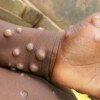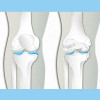
 Mr. Swapnil Bhowmick
Mr. Swapnil Bhowmick
Knee Replacement - Medtalks
Knee replacement is a term used to describe the replacement of a knee joint. Knee joint replacement is a technique in which an artificial joint, or prosthetics, is used to replace a wounded or diseased knee. Metal alloys, plastics, and polymers are used to construct the prosthesis. It functions similarly to a knee.
Your doctor will consider the following factors when choosing a prosthetic knee:
Age
Weight
Degree of exercise
Overall health
Although the process to remove your old knee and replace it with a prosthetic takes less than two hours, recuperation and therapy might take months. Knee arthroplasty is another term for this treatment. Knee replacement surgery is a highly common procedure.
Purpose of Knee Replacement Surgery
The most prevalent reason for knee joint replacement is arthritic damage. Both osteoarthritis and rheumatoid arthritis fall under this category. It is normally recommended only after other, less invasive therapies have failed. The following are some of the first-line treatments:
Medication
Weight loss
Assistance gadgets for physical treatment (such as a cane or a knee brace)
Knee Surgery is a common therapeutic option for persons over 55. Younger persons who have their knees replaced may outlast their replacements and require revision surgery.
How to Prepare for Knee Replacement Surgery?
Your doctor will evaluate your general health and anaesthetic risks prior to surgery. This assessment will involve the following:
A comprehensive medical history
An examination of the body
Blood tests
X-rays
Additional imaging examinations
Your doctor will inquire about your whole medical history, including any previous procedures and current medical issues. Any medications you're taking, including over-the-counter drugs and nutritional supplements, should be disclosed to your doctor. Before your operation, you may need to stop taking any or all of these.Also, if you've ever had an allergic response to anaesthesia, notify your doctor. Your doctor will discuss your anaesthetic choices with you, according to your preferences and what they believe is best for you. This might involve general anesthesia, in which case you'll be sleeping during the procedure. Else,you may be given spinal anesthetic, leaving you awake but pain-free from the waist down. Your doctor will share the results of your medical examination, medical history, and anaesthetic preference with your surgeon.
For several weeks, you should anticipate walking with crutches or a walker. Try these things before surgery:
Handles may be required in showers and around the toilet.
It's beneficial to have a chair and a foot-rest nearby so you may raise your leg.
If you have a multi storey property, keep your living area on the ground floor, if at all feasible.
Your surgeon and doctor will provide you with detailed information on how to effectively prepare for surgery. It's critical to adhere to their directions as strictly as possible.
What Happens during Knee Replacement Surgery?
When it's time for surgery, you'll change into a hospital gown and be given an IV to keep you hydrated and fed during the procedure. You'll be given anaesthetic right before operation.Your surgeon will make a lengthy surgical cut above your knee during the surgery, which will last between one and two hours. They'll cut away damaged cartilage and bone with the skin and muscle pushed back.
They'll attach the replacement knee joint to your femur, or thighbone, and tibia, or lower leg's main bone. They'll use specialised cement, pins, and screws to do this. After that, your surgeon will use stitches to seal the incision wound and apply a bandage. A special team is appointed to monitor your progress and vitals.
After Knee Replacement Surgery
Your leg will be stiff after surgery. Painkillers administered intravenously can assist in controlling this discomfort. Long-acting local anaesthetics or a nerve block may be administered during surgery to alleviate postoperative discomfort.
To increase blood flow to the tissues around the new knee, most individuals begin physical therapy the day of surgery or the day after surgery. A continuous passive-motion machine may be recommended by your surgeon. This is a unique brace-like gadget that gently bends your knee in a continuous motion.When it's time to leave the hospital, your surgeon will advise you. This is determined by the outcome of the operation as well as your current health. You'll need to do a lot of physical rehabilitation after your operation.
Complications Associated with Knee Replacement Surgery
Bleeding, blood clots, and infection are among risks associated with medical procedures. These dangers will be discussed with you by your doctor, as well as what you may do to reduce them.
Knee replacement surgery can result in the following complications:
Blood clots in the leg or lungs
Prosthetic knee wearing down over time
Anesthesia-induced breathing issues
Knee stiffness
Heart attack
A stroke
Nerve injury in the knee
If you have any of the following symptoms, see your doctor right away:
Your surgical scar is causing you to have goosebumps
A temperature of more than 100 degrees Fahrenheit (37.8 degrees Celsius)
Knee discomfort
Redness
Edema
Worsening soreness
For patients who have prosthetic joints, infection is a constant issue. Bacteria and other impurities can infect your artificial knee since they pass through your bloodstream on a regular basis. If you have a knee infection, your doctor may need to remove a portion of or the entire artificial knee to treat the infection before re-implanting one.

Mr. Swapnil Bhowmick
A motivated student of Medicine & Surgery (MBBS) at R. G. Kar Medical College & Hospital, Kolkata, having a knack for reading and composing medical literature. When he's not writing content for MEDtalks, Swapnil is usually looking up the latest trends and innovations in Medicine.




















Please login to comment on this article